
The aim of the course is for students to develop their knowledge and skill at interpreting, integrating and synthesizing ideas about diverse political, economic, societal, and technical trends, discontinuities, and systems that will shape the future. Simply stated: How does one make sense of an increasingly complex world? A primary text for the course will be the recently released report, Global Trends: Paradox of Progress (2017), which governments, industry, and non-governmental organizations use for strategic foresight and planning. A central theme of the course is to learn how technological innovations change the way large-scale, complex, sociotechnical systems function – systems such as critical infrastructure: transportation, energy, communications, health, as well as the convergence among these systems – in relationship to economic competitiveness, environmental sustainability, national and global security, and societal well-being. The ability to understand the changing nature of these complex systems is also related to how technology is changing the systems of education, learning, and workforce development. The course will interest students from across disciplines, who seek to understand how global trends and particularly how changing technologies and sociotechnical systems will influence your future. For science and engineering students, the course will place your technical studies in a larger political, economic, societal, and technological systems context.
A systems and scenario analytic approach will be used to think through and integrate the diverse political, economic, societal, and technological factors that shape the future. The construction of alternative scenarios enables multiple stakeholders with different points of view to think through the consequences of action and interactions. The point of the analysis is not to predict the future, but rather to identify opportunities and risks that individuals and organizations may face so that they are better prepared to seize opportunities and to manage risks effectively. Strategic leadership requires an understanding of the trends that influence increasingly interconnected and interdependent systems of systems and that directly influence the quality of our lives. The course is an introduction to a holistic way of understanding the current state, and possible future states of the world and the human condition given differences in cultures, values, and beliefs.

This course introduces the student to the philosophy, origins, theory, principles, and methodologies of complex socio-technical systems. The purpose of the course is to develop and foster the type of holistic thinking needed to be an effective systems engineer.

Students work on projects to address large, complex and seemingly intractable real-world problems, such as energy supply, environmental issues, health care delivery, and critical infrastructure (e.g., telecommunications, water supply, and transportation). Introduces interdisciplinary approaches - rooted in engineering, management, and the social sciences - for considering these critical contemporary issues. Small, faculty-led teams select an engineering systems term project to illustrate several of these approaches.
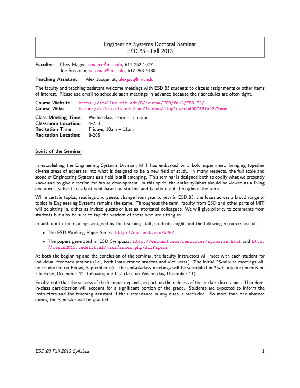
In establishing the Engineering Systems Division, MIT has embarked on a bold experiment: bringing together diverse areas of expertise into what is designed to be a new field of study. In many respects, the full scale and scope of Engineering Systems as a field is still emerging. This seminar is designed both to codify what we presently know and to give direction for future development. In this spirit, the entire syllabus should be viewed as a living document, subject to adjustment based on student and faculty input throughout the term.
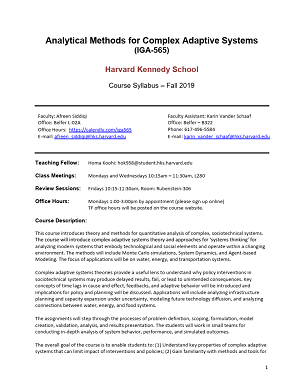
This course introduces theory and methods for quantitative analysis of complex, sociotechnical systems. The course will introduce complex adaptive systems theory and approaches for ‘systems thinking’ for analyzing modern systems that embody technological and social elements and operate within a changing environment. The methods will include Monte Carlo simulations, System Dynamics, and Agent-based Modeling. The focus of applications will be on water, energy, and transportation systems.
Complex adaptive systems theories provide a useful lens to understand why policy interventions in sociotechnical systems may produce delayed results, fail, or lead to unintended consequences. Key concepts of time lags in cause and effect, feedbacks, and adaptive behavior will be introduced and implications for policy and planning will be discussed. Applications will include analyzing infrastructure planning and capacity expansion under uncertainty, modeling future technology diffusion, and analyzing connections between water, energy, and food systems.
The assignments will step through the processes of problem definition, scoping, formulation, model creation, validation, analysis, and results presentation. The students will work in small teams for conducting in-depth analysis of system behavior, performance, and simulated outcomes. The overall goal of the course is to enable students to: (1) Understand key properties of complex adaptive systems that can limit impact of interventions and policies; (2) Gain familiarity with methods and tools for studying system behavior and understand their strengths and limitations; and (3) Systematically conceptualize and build simulation models for conducting quantitative analysis.
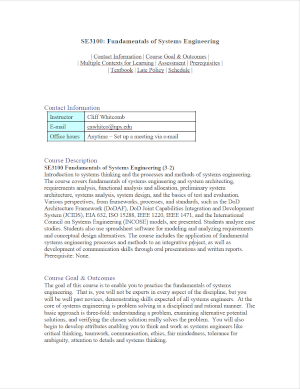
Introduction to systems thinking and the processes and methods of systems engineering. The course covers fundamentals of systems engineering and system architecting, requirements analysis, functional analysis and allocation, preliminary system architecture, systems analysis, system design, and the basics of test and evaluation. Various perspectives, from frameworks, processes, and standards, such as the DoD Architecture Framework (DoDAF), DoD Joint Capabilities Integration and Development System (JCIDS), EIA 632, ISO 15288, IEEE 1220, IEEE 1471, and the International Council on Systems Engineering (INCOSE) models, are presented. Students analyze case studies. Students also use spreadsheet software for modeling and analyzing requirements and conceptual design alternatives. The course includes the application of fundamental systems engineering processes and methods to an integrative project, as well as development of communication skills through oral presentations and written reports.

At a high level, we wish to better understand physical systems and their interactions with human society. This leads to four areas of discussion:
In terms of content, the course will focus on Systems theory, Linear systems; Nonlinear dynamic systems; Spatial systems; Heavy-tailed or Power-law distributions; Complex systems, and Inverse problems

This textbook explains Technology Roadmapping, in both its development and practice, and illustrates the underlying theory of, and empirical evidence for, technologic evolution over time afforded by this strategy. The book contains a rich set of examples and practical exercises from a wide array of domains in applied science and engineering such as transportation, energy, communications, and medicine. Professor de Weck gives a complete review of the principles, methods, and tools of technology management for organizations and technologically-enabled systems, including technology scouting, roadmapping, strategic planning, R&D project execution, intellectual property management, knowledge management, partnering and acquisition, technology transfer, innovation management, and financial technology valuation. Special topics also covered include Moore’s law, S-curves, the singularity and fundamental limits to technology. Ideal for university courses in engineering, management, and business programs, as well as self-study or online learning for professionals in a range of industries, readers of this book will learn how to develop and deploy comprehensive technology roadmaps and R&D portfolios on diverse topics of their choice.

Complex Systems lie at the heart of a variety of large-scale phenomena of great significance - global warming, ice ages, water, poverty, pandemics - and this text uses these case studies as motivations and contexts to explore complex systems and related topics of nonlinear dynamics and power-law statistics. Although detailed mathematical descriptions of these topics can be challenging, the consequences of a system being nonlinear, power-law, or complex are in fact quite accessible. This book blends a tutorial approach to the mathematical aspects of complex systems together with a complementary narrative on the global/ecological/societal implications of such systems.
Nearly all engineering undergraduate courses focus on mathematics and systems which are small scale, linear, and Gaussian. Unfortunately there is not a single large-scale ecological or social phenomenon that is scalar, linear, and Gaussian. This book offers insights to better understand the large-scale problems facing the world and to realize that these cannot be solved by a single, narrow academic field or perspective. Instead, the book seeks to emphasize understanding, concepts, and ideas, in a way that is mathematically rigorous, so that the concepts do not feel vague, but not so technical that the mathematics get in the way. The book is intended for students in technical domains such as engineering, computer science, physics, mathematics, and environmental studies.
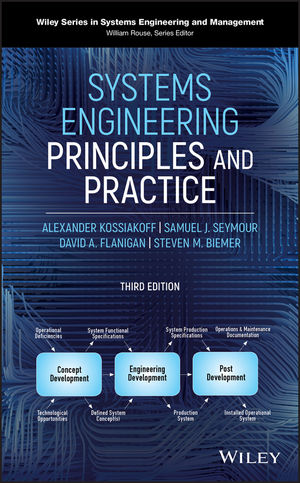
Systems Engineering: Principles and Practice, 3rd Edition is the leading interdisciplinary reference for systems engineers. The up-to-date third edition provides readers with discussions of model-based systems engineering, requirements analysis, engineering design, and software design. Freshly updated governmental and commercial standards, architectures, and processes are covered in-depth. The book includes newly updated topics on:
Examples and exercises appear throughout the text, allowing the reader to gauge their level of retention and learning. Systems Engineering: Principles and Practice was and remains the standard textbook used worldwide for the study of traditional systems engineering. The material is organized in a manner that allows for quick absorption of industry best practices and methods.
Throughout the book, best practices and relevant alternatives are discussed and compared, encouraging the reader to think through various methods like a practicing systems engineer.

This book explores the ways that disciplinary convergence and technological advance are transforming systems engineering to address gaps in complex systems engineering: Transdisciplinary Systems Engineering (TSE). TSE reaches beyond traditional disciplines to find connections—and this book examines a range of new methods from across such disparate areas of scholarship as computer science, social science, human studies, and systems design to reveal patterns, efficiencies, affordances, and pathways to intuitive design. Organized to serve multiple constituencies, the book stands as an ideal textbook supplement for graduate courses in systems engineering, a reference text for program managers and practicing engineers in all industries, and a primary source for researchers engaged in multidisciplinary research in systems engineering and design.
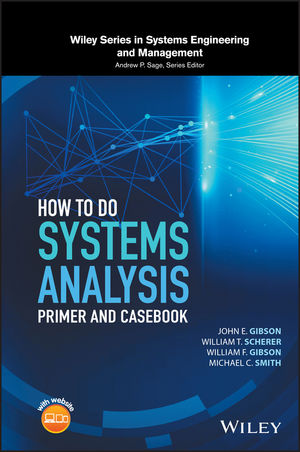
This book emphasizes the underlying systems analysis components and associated thought processes. The authors describe an approach that is appropriate for complex systems in diverse disciplines complemented by a case-based pedagogy for teaching systems analysis that includes numerous cases that can be used to teach both the art and methods of systems analysis.
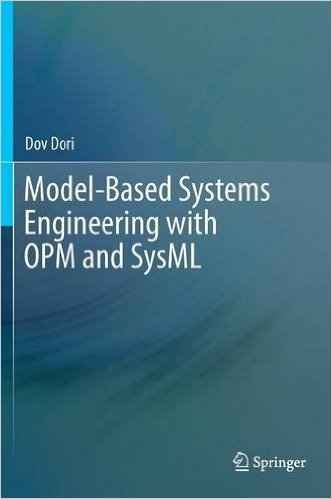
Model-Based Systems Engineering (MBSE), which tackles architecting and design of complex systems through the use of formal models, is emerging as the most critical component of systems engineering. This textbook specifies the two leading conceptual modeling languages, OPM―the new ISO 19450, composed primarily by the author of this book, and OMG SysML. It provides essential insights into a domain-independent, discipline-crossing methodology of developing or researching complex systems of any conceivable kind and size. Combining theory with a host of industrial, biological, and daily life examples, the book explains principles and provides guidelines for architecting complex, multidisciplinary systems, making it an indispensable resource for systems architects and designers, engineers of any discipline, executives at all levels, project managers, IT professional, systems scientists, and engineering students.

System architecture is the study of early decision making in complex systems. This text teaches how to capture experience and analysis about early system decisions, and how to choose architectures that meet stakeholder needs, integrate easily, and evolve flexibly. With case studies written by leading practitioners, from hybrid cars to communications networks to aircraft, this text showcases the science and art of system architecture.

Beyond Alignment: Applying Systems Thinking to Architecting Enterprises is a comprehensive reader about how enterprises can apply systems thinking in their enterprise architecture practice, for business transformation and for strategic execution. The book’s contributors find that systems thinking is a valuable way of thinking about the viable enterprise and how to architect it.
Edited by John Gøtze and Anders Jensen-Waud, the book features contributions from 32 international experts in the fields of systems thinking and enterprise architecture.
Contributors
Adrian Campell, Alex Conn, Dennis Sherwood, Don deGuerre, Erik Perjons, Gene Bellinger, Harold “Bud” Lawson, Ilia Bider, Jack Ring, James Lapalme, James Martin, Jan Dietz, Jan Hoogervorst, Janne J. Korhonen, John Morecroft, Leo Laverdure, Linda Clod Praestholm, Mesbah Khan, Mikkel Stokbro Holst, Namkyu Park, Olov Östberg, Olusola O. Oduntan, Patrick Hoverstadt, Per Johannisson, Per-Arne Persson, Peter Sjølin, Rasmus Fischer Frost, Sally Bean, Tom Graves, and Tue Westmark Steensen.

Design structure matrix (DSM) is a straightforward and flexible modeling technique that can be used for designing, developing, and managing complex systems. DSM offers network modeling tools that represent the elements of a system and their interactions, thereby highlighting the system’s architecture (or designed structure). This book addresses the four primary types of DSM models, offering tools for representing product architectures, organization architectures, process architectures, and multidomain architectures (which combine different types of DSM models to represent multiple domains simultaneously). Each chapter provides many real-world examples of applications of the DSM types, representing a wide range of industries (including automotive, aerospace, electronics, building, and pharmaceutical), countries (among them Australia, Germany, Japan, Turkey, and the United States), and problems addressed (modularity, outsourcing, system integration, knowledge management, and others).

The mathematization of the sciences, of engineering, and of economics has been an outstandingly successful intellectual enterprise, enabling the modern world. As the operations of the world become more and more dependent on highly interconnected, massively complex, networked systems of computational devices, the need to develop a mathematical understanding of their properties and behaviours is increasingly pressing.
Our approach, described in this monograph, is to combine the compositionality of formal specification –– using techniques from algebra, computation theory, logic, and probability theory –– with the control of level of abstraction afforded by the classical mathematical modelling method.
The first chapter provides a complete high-level view of the approach to systems modelling that is developed in the monograph. It provides both conceptual and philosophical background and introductions to the technical development. The remaining chapters develop the mathematical and computational aspects of our approach. Each chapter develops a specific mathematical or computational component, clearly integrated into the overall development. Examples, including ones based on industrial and commercial applications, are provided throughout. An implementation of a simulation engine (Core Gnosis) for executing models is available.
Contents

Engineering has experienced a technological revolution, but the basic engineering techniques applied in safety and reliability engineering, created in a simpler, analog world, have changed very little over the years. In this groundbreaking book, Nancy Leveson proposes a new approach to safety—more suited to today’s complex, sociotechnical, software-intensive world—based on modern systems thinking and systems theory. Revisiting and updating ideas pioneered by 1950s aerospace engineers in their System Safety concept, and testing her new model extensively on real-world examples, Leveson has created a new approach to safety that is more effective, less expensive, and easier to use than current techniques.

Engineering, for much of the twentieth century, was mainly about artifacts and inventions. Now, it’s increasingly about complex systems. As the airplane taxis to the gate, you access the Internet and check email with your PDA, linking the communication and transportation systems. At home, you recharge your plug-in hybrid vehicle, linking transportation to the electricity grid. Today’s large-scale, highly complex sociotechnical systems converge, interact, and depend on each other in ways engineers of old could barely have imagined. As scale, scope, and complexity increase, engineers consider technical and social issues together in a highly integrated way as they design flexible, adaptable, robust systems that can be easily modified and reconfigured to satisfy changing requirements and new technological opportunities. Engineering Systems offers a comprehensive examination of such systems and the associated emerging field of study. Through scholarly discussion, concrete examples, and history, the authors consider the engineer’s changing role, new ways to model and analyze these systems, the impacts on engineering education, and the future challenges of meeting human needs through the technologically enabled systems of today and tomorrow.
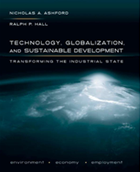
In this book Nicholas A. Ashford and Ralph P. Hall offer a unified, transdisciplinary approach for achieving sustainable development in industrialized nations. They present an insightful analysis of the ways in which industrial states are currently unsustainable and how economic and social welfare are related to the environment, to public health and safety, and to earning capacity and meaningful and rewarding employment. The authors argue for the design of multipurpose solutions to the sustainability challenge that integrate economics, employment, technology, environment, industrial development, national and international law, trade, finance, and public and worker health and safety. This book is essential reading for anyone with a policy or scholarly interest in sustainable development and the critical roles of the economy, employment, and the environment.

Project teams can improve results by recognizing that the future is inevitably uncertain and that by creating flexible designs they can adapt to eventualities. This approach enables them to take advantage of new opportunities and avoid harmful losses. Designers of complex, long-lasting projects—such as communication networks, power plants, or hospitals—must learn to abandon fixed specifications and narrow forecasts. They need to avoid the “flaw of averages,” the conceptual pitfall that traps so many designs in underperformance. Failure to allow for changing circumstances risks leaving significant value untapped. This book is a guide for creating and implementing value-enhancing flexibility in design. It will be an essential resource for all participants in the development and operation of technological systems: designers, managers, financial analysts, investors, regulators, and academics.
The book provides a high-level overview of why flexibility in design is needed to deliver significantly increased value. It describes in detail methods to identify, select, and implement useful flexibility. The book is unique in that it explicitly recognizes that future outcomes are uncertain. It thus presents forecasting, analysis, and evaluation tools especially suited to this reality. Appendixes provide expanded explanations of concepts and analytic tools.

Systems are everywhere and affect us daily in our private and professional lives. We all use the word “system” to describe something that is essential but often abstract, complex and even mysterious. However, learning to utilize system concepts as first class objects as well as methodologies for systems thinking and systems engineering provides a basis for removing the mystery and moving towards mastery even for complex systems.
This journey through the Systems Landscape has been developed to promote learning to “think” and “act” in terms of systems. A unique aspect is the introduction of concrete system semantics provided as a “system survival kit” and based upon a limited number of concepts and principles as well as a mental model called the system-coupling diagram. This discipline independent presentation assists individuals and is essential for building a learning organization that can utilize a systems approach to achieving its enterprise goals.
The eight chapters are presented as stops along a journey that successively build system knowledge. Each chapter terminates with a Knowledge Verification section that provides questions and exercises for individuals and groups. Case studies reflecting the utilization of the system related concepts, principles and methodologies are provided as chapter interludes.

Object-Process Methodology (OPM) is a comprehensive novel approach to systems engineering. Integrating function, structure and behavior in a single, unifying model, OPM significantly extends the system modeling capabilities of current object-oriented methods. Founded on a precise generic ontology and combining graphics with natural language, OPM is applicable to virtually any domain of business, engineering and science. Relieved from technical issues, system architects can use OPM to engage in the creative design of complex systems.
The book presents the theory and practice of OPM with examples from various industry segments and engineering disciplines, as well as daily life.